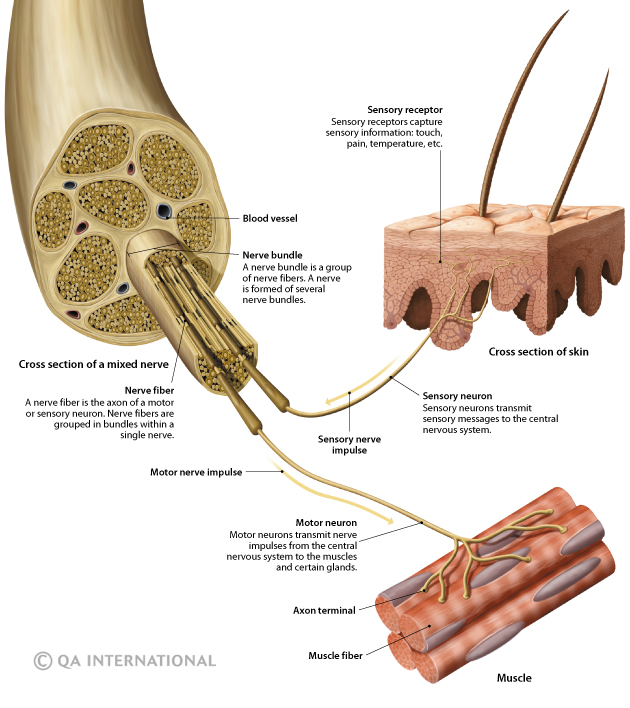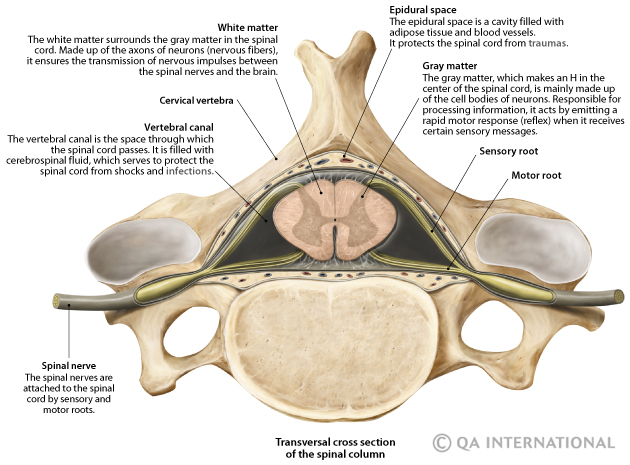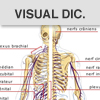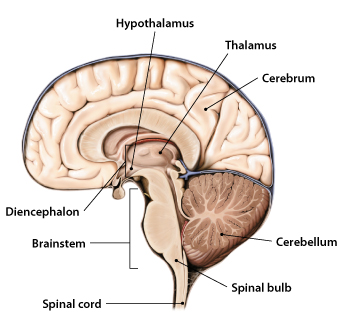
The nervous system: more than 90,000 miles of sensations!
The structure of the nervous system
The nervous system allows our bodies to perceive sensations, to think and to perform all of our movements, both voluntary and involuntary. It is composed of the brain, the spinal cord and the nerves. Anatomically speaking, the nervous system is comprised of the central nervous system (the brain and the spinal cord, which are the interpretation and command centers), and the peripheral nervous system, which is composed of the nerves (the transmission network).
 Structure of the Nervous System
Structure of the Nervous System
How the nervous system works
Functionally speaking, the nervous system is comprised of the somatic nervous system and the autonomic nervous system. The somatic nervous system, or voluntary system, makes it possible for the body to interact with its environment. It acts only on the skeletal muscles and governs voluntary movements, reflexes and semiautomatic movements (maintaining balance, posture, walking) as well as receives the sensory messages from the skin and the sensory organs.
The autonomic nervous system regulates unconscious visceral functions: breathing, digestion, heart rhythm, blood circulation, excretion, etc. It acts on the smooth muscles (which enable the involuntary movements of the organs), certain glands, the vascular system and the heart muscle.
Video : The motor functions of the nervous system
 The Nerves
The Nerves
The neurons
In the nervous system, information is carried in the form of electrical and chemical signals by highly complex cells called neurons. The human body contains some 100 billion neurons, which form a part of the nervous tissue (the brain, the spinal cord and the nerves).
Although their shape can vary, all of the neurons have a similar structure: a cell body with extensions (dendrites and an axon), which provide for the reception and transmission of nerve messages. In the peripheral nervous system, these extensions form nerve fibers that make up the nerves. Neurons can only survive for a few minutes without oxygen, and most of them are unable to divide.
 The Transmission of messages by neurons
The Transmission of messages by neurons
The neurons differ from the other cells in the body by their exceptionally long life span. Even though, starting at birth, we lose many neurons every minute of our lives, some of them can, just like us, survive for more than 100 years!
The spinal cord
The spinal cord is formed by a cord of nervous tissue more than 16 inches (40 cm) in length located in the vertebral canal, inside the spinal column. It spans from the spinal bulb to the second lumbar vertebra and is extended by a collection of nervous fibers, the cauda equina. Composed of motor and sensory neurons, the spinal cord ensures the transmission of messages between the spinal nerves and the brain, in addition to being a reflex center.

The spinal cord is elastic, and stretches during movements of the head and trunk. However, it is fragile and very sensitive to direct pressure. A lesion of the spinal cord leads to a function, motor or sensory loss, the extent of which depends on the location of the lesion.
Anatomical glossary
- Brain: Part of the central nervous system enclosed in the skull, consisting of the brain, cerebellum and brain stem; it is responsible for sensory perception, most movements, memory, language, reflexes and vital functions. Locate the brain in the Virtual Human Body >
- Spinal cord: Part of the central nervous system located in the vertebral canal, inside the vertebral column; it transmits nerve information from the spinal nerves to the brain and back, and triggers reflexes. Locate the spinal cord in the Virtual Human Body >
- Spinal nerves: All of the 31 pairs of mixed nerves (sensory and motor) emerging from the spinal cord and innervating all parts of the body, except the face. Locate the spinal nerves in the Virtual Human Body >
- Lumbar vertebrae: Massive vertebrae (5) located beneath the thoracic vertebrae at the abdomen. Locate the lumbar vertebrae in the Virtual Human Body >
ALSO SEE

|
The "Nervous System" section |
|---|---|

|
Infographic: Blood's long journey Propelled by the heart, blood circulates throughout the body through a vast network consisting of arteries, arterioles, capillaries, veinlets and veins. [...] |

|
Preventing and relieving backache Backaches are extremely common. At least one in two people will suffer from them at some point in their life. In fact, a backache is not actually a disease: it is a symptom. [...] |

|
Virtual Human Body |






